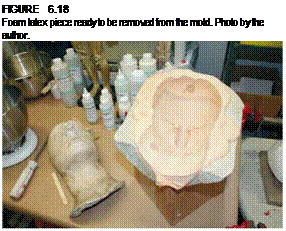
Once you determine that your foam is fully cured, turn off the oven and let the molds begin to cool. If you try to cool the molds too rapidly, they will crack and break; you do not want to rush the process! When the molds are still warm to the touch, you can carefully demold your appliances; they will come out more easily when warm than if you let the molds cool completely. Carefully pry the mold halves apart and help remove the appliance with the use of a blunt wooden tool (so you don’t scratch the mold’s surface detail), powdering as you go to keep the thin foam edges from sticking together. I want to stress this point: You probably went to a fair amount of trouble to ensure that your appliance would have thin, beautiful edges; if you are not careful and methodical about powdering the appliance during removal, your thin beautiful edges will fold over on themselves and become thick ugly edges that you can’t separate.
After you’ve removed the appliance, it must be gently washed in warm water containing only a few drops of dishwashing liquid (I use either Ivory or Palmolive dish soap) to remove any residual sulfur from the curing agent. Repeat this procedure until there is no more visible residue in the water, then rinse until all the soap is gone, and gently squeeze out the water; you might want press the appliance between two towels, then allow it to dry completely on the lifecast so that it will maintain its shape.

![]()
When the foam pieces have been washed, dried, and powdered, they should be stored resting in their natural curvature in airtight containers, away from light if possible. It is convenient to use either zip-lock plastic bags or plastic refrigerator containers that have airtight lids. These baggies or plastic containers can then be stored
in a cardboard box or any other opaque container that can keep out the light. If stored like this, foam latex pieces can be kept for years without any deterioration. If a foam piece is stored or left to air out with a crease or fold in it, the piece could wind up with a permanent crease line or indentation. Store the appliances in their natural curvature.
Now the foam is ready for painting and application.
The appendix at the back of this book includes more detailed information from GM Foam about run schedules.
